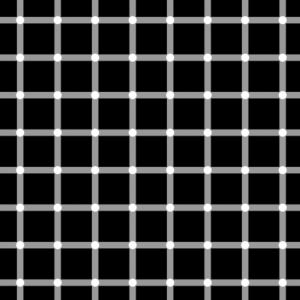Optical Illusions: Difference between revisions
(Created page with "Optical illusions are a great initiation point for people to start to explore Pivotal Mental States.") |
No edit summary |
||
| Line 1: | Line 1: | ||
Optical illusions are a great initiation point for people to start to explore [[Pivotal Mental States]]. | Optical illusions are a great initiation point for people to start to explore [[Pivotal Mental States]]. Optical illusions provide the observer a quirk of perception which may seem strange at first however they can often be explained from a evolutionary psychology perspective. | ||
== Grid Illusion or ''Scintillating Grid'' == | |||
[[File:Grid illusion.png|alt=Grid illusion|thumb|Grid illusion]] | |||
The scintillating grid is a ''simultaneous lightness contrast'' illusion. | |||
=== Effect === | |||
Dots which are not centred in your visual field should appear to flash from black to white, in a 'scintillating' effect. | |||
=== Mechanism === | |||
It is thought the reason for the illusion is physiological. The mechanism proposed by Baumgartner (1960) detailed that the effect might be due to inhibitory processes in the retinal ganglion cells, the neurons that transmit signals from the eye to the brain. To each cell there corresponds a small region of the retina called the receptive field, where photoreceptive rods and cones can trigger an electrical response in that cell. The receptive fields of adjacent ganglion cells may overlap. | |||
Revision as of 00:47, 15 August 2022
Optical illusions are a great initiation point for people to start to explore Pivotal Mental States. Optical illusions provide the observer a quirk of perception which may seem strange at first however they can often be explained from a evolutionary psychology perspective.
Grid Illusion or Scintillating Grid
The scintillating grid is a simultaneous lightness contrast illusion.
Effect
Dots which are not centred in your visual field should appear to flash from black to white, in a 'scintillating' effect.
Mechanism
It is thought the reason for the illusion is physiological. The mechanism proposed by Baumgartner (1960) detailed that the effect might be due to inhibitory processes in the retinal ganglion cells, the neurons that transmit signals from the eye to the brain. To each cell there corresponds a small region of the retina called the receptive field, where photoreceptive rods and cones can trigger an electrical response in that cell. The receptive fields of adjacent ganglion cells may overlap.
